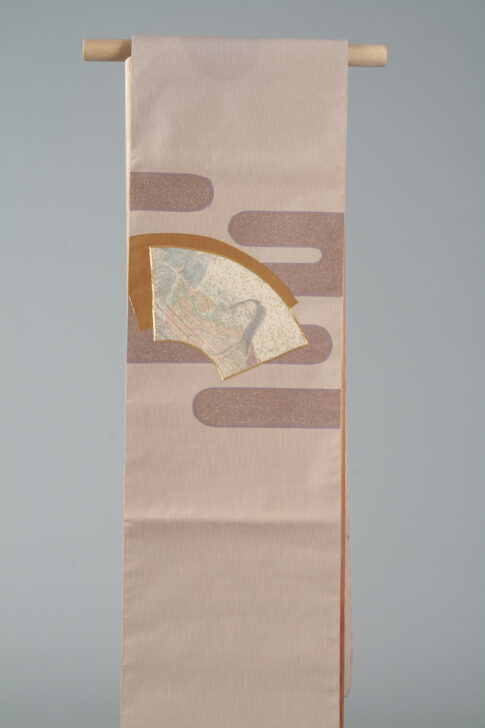Obi
Japanese

Description
An obi (the sash used to tie a kimono) is an important component of modern Japanese formal attire. It has been in use since at least the Heian period (794–1185), when Tales of the Heike and The Tale of Genji were written. Kimono are loose-fitting, and an obi lends the
outfit structure. The meandering pattern on this obi—rendered in a darker shade of purple—gives this traditional garment a modern edge, while the hand-painted image depicts a Heian-period court lady dressed in the traditional jūnihitoe (twelve layers) style, which
was comprised of up to twelve layers of kimono. While this mode of dress restricts movement, on rare occasions it is still worn today, as observed during the 2019 enthronement ceremony of the Emperor and Empress of Japan.
Subject Matter:
The folding fan, introduced from China, opens out into a form that suggests unfolding potential, symbolizing growing prosperity and expanding possibilities. One of the fans depict a Japanese court lady wearing twelve layers of kimono. To the right of her are two Kanji characters, though illegible.
Nishijin-ori textiles were developed in the Nishijin area of Kyoto city and has dominated the production of high-quality woven textiles since the fifteenth century. Nishiki is a type of vibrant silk brocade with vivid and luxurious images using various colorful and metallic (mainly gold and silver). Nishiki brocade is mainly produced in the Nishijin area of Kyoto. Nagoya obi were first produced at the end of the Taisho era, and are shorter than the more formal fukuro and maru obi. A portion of Nagoya obi fabric is folded and stitched in half to make tying easier. Gara refers to the orientation, arrangement, and surface area of the patterns and pertains to a specific trend and obi tying style. The patterning in the Otaiko gara type is minimal. A few concentrated spots of patterned motif lie on the obi while the rest is left blank. This style was invented during the Edo period (1615-1868) by the female entertainers in Fukugawa, an entertainment district in present-day Tokyo.
Physical Description:
Lavender-beige Nagoya obi with interwoven gold and lavender cloud fog motifs and patched brown and narrative fans.
Usage Rights:
If you are interested in using an image for a publication, please visit https://umma.umich.edu/request-image/ for more information and to fill out the online Image Rights and Reproductions Request Form.